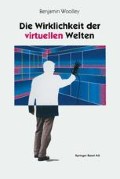Zusammenfassung
Howard Rheingold schreibt in seinem Buch über virtuelle Realität, wir stünden an der Schwelle zu dem «Vermögen, uns jedes Erlebnis verschaffen zu können, das wir wünschen.»1 Damit ist die Position des, wie man ihn nennen könnte, naiven virtuellen Realisten umrissen. Für Menschen wie Rheingold ist der Computer eine Realitätsmaschine ohne Grenzen, die jede Welt erschaffen kann, in der wir leben möchten. Diese Schwelle: Wie nahe ist sie? Wann werden wir über diese Macht verfügen, und wie werden wir sie erwerben?
Access this chapter
Tax calculation will be finalised at checkout
Purchases are for personal use only
Preview
Unable to display preview. Download preview PDF.
Anmerkungen
Howard Rheingold: Virtuelle Welten. Reinbek (Rowohlt) 1992, S. 594.
Ders.: Teledoldonics: reach out and touch someone. In: Mondo 2000, 2, Sommer 1990, S. 52.
Kenneth M. Sheldon: Micro 2000. In: Byte, 16(4), April 1991, S. 132.
Jon Palfreman; Doron Swade: The Dream Machine. London (BBC) 1991, S. 186.
Ebd., S. 103.
Stewart Brand: The Media Lab. London (Penguin) 1989, S. 123.
Rheingold, 1992, S. 580–587.
In: Rheingold, 1992, S. 439.
Gregory MacNicol: What’s wrong with reality? Computer Graphics World, 13 (11), 1990, S. 104.
Aus: The Oxford Dictionary of Quotations, 1979, S. 275.
Siehe Christopher Norris: Uncritical Theory. London (Lawrence and Wishart) 1992.
Late Show, BBC2, 4. Juni 1991.
In: Benjamin Woolley: Down to earth. In: The Listener, 120(3083), 6. Oktober 1988, S. 4.
Greg Freiherr: Rediscovering the outer planets. Computer Graphics World, 14 (7), 1991, S. 40.
Elisabeth Geake: Speedy Computers hit the price barrier. In: New Scientist 132(1797), 30. November 1991, S. 27.
Elizabeth Corcoran: Calculating reality. Scientific American, 264 (1), 1991, S. 75.
Rights and permissions
Copyright information
© 1994 Springer Basel AG
About this chapter
Cite this chapter
Woolley, B. (1994). Ausblicke. In: Die Wirklichkeit der virtuellen Welten. Birkhäuser, Basel. https://doi.org/10.1007/978-3-0348-6179-3_13
Download citation
DOI: https://doi.org/10.1007/978-3-0348-6179-3_13
Publisher Name: Birkhäuser, Basel
Print ISBN: 978-3-0348-6180-9
Online ISBN: 978-3-0348-6179-3
eBook Packages: Springer Book Archive

